Rudra’s Army Attacks Mumbai A Study of Terrorism in Mundane Astrology by Robert A. Koch, USA
Article by Robert A. Koch, USA
“Of all the Rudras I am Lord Çiva; of the Yakñas and Räkñasas I am the lord of wealth [Kuvera]; of the Vasus I am fire [Agni], and of the mountains I am Meru.” — Bhagavad-gétä, 10.23
Among events in human society that can impact the future of the planet, acts of terrorism may stand out as the most dangerous and destructive. Terrorism is a word which defines the tactics sought by certain covert forces to overthrow a government. These could involve individual assassinations of government heads, or reckless attacks on civilian populations as well. Whatever the motive, the end result is destructive to human life and thus the topic warrants a careful look in analyses of the astrological charts pertaining to countries and their governments.
On November 26, 2008, a covert militant organization launched a terrible and violent attack against India’s most important and vibrant financial center, the city of Mumbai. While the result of the attack might not have been considered as catastrophic as the September 11, 2001 attacks against New York City, it represented an unnecessary and horrific loss of innocent human life, as well as widespread destruction of the city’s infrastructure. This event and one’s similar
to it set the stage for analysis in mundane astrology. Although the event itself was tragic, it still gives astrologers opportunity to go deeper into the science of Jyotish where horoscopes of countries and their governments are concerned. The study of relevant charts and systems of timings will be presented in the paragraphs that follow.
Basic Principles of Mundane Astrology
Whereas the wider majority of astrological analysis involves studies of individual natal charts, mundane astrology presents an array of specific techniques for analyzing the destinies of countries. There are specific assignments of planets, signs, and houses to the affairs of certain countries that differ from those of natal chart analysis. A complete description of these is beyond the scope of this article, but reference to such specific assignments will be made herein when applicable to the charts being studied. The date of calculation for such charts, how planetary interplay and yogas apply, as well as the timing of the results of karma for the country for a given year differ from natal charts also. With the analysis of India’s mundane chart for the year 2008, many important aspects of mundane astrology will be presented. Since the subject matter is vast, a series of articles or a book of case studies on this subject might be necessary. The author wishes to bring forward this kind of research in this important area of Jyotish in future projects.
Calculation of the Mundane Chart – Place and Date
The mundane chart of a country is essentially an annual chart which is cast from specific points in time during the current year. The place for calculating the chart is generally the capitol city of that country, although some astrologers use specific cities of that country for the place of calculation. In practice, the place of the capitol city of a country gives the best results in terms of destinies and outcomes for the year, however.
There are a number of dates during the year that are used for the time of calculation. Among the more popular of these are listed as follows:
Lunar New Year: The lunar New Year chart is cast for the time of the New Moon in Pisces which occurs every year between March and April. This calculation point is the most important and widely used in Vedic astrology and is the most consistently accurate for the general outcome of events for the coming year.
Lunation charts: The lunation chart is cast for new and full Moons throughout the year, although they for the most part give results pertaining to a one month period of time only. The late B.V. Raman, however, apparently used these extensively and applied the results to the entire year.
Financial New Year chart: This is calculated for the time of the New Moon in Libra, and can be an accurate barometer as to the changes in the economy of a particular country. The outcomes indicated in the financial New Year chart may be observed for one year’s time.
This chart can also be used for corporations or businesses, and often business owners in India consult this chart to ascertain the movements of markets throughout the year.
Solar Eclipse charts: While the new and full Moon occur twelve times per year, the new moon solar eclipse on average, occurs only twice per year. Thus the chart cast for the new moon at the time of the solar eclipse is very important. It is said that the results of this chart last for as many years as the duration of the eclipse in hours. The solar eclipse chart, however, should be calculated for the exact time of the new moon on the day of the eclipse, and not the time of the eclipse itself.
Apart from times to calculate the chart, Eclipse points – both solar and lunar – are important references so far as timings are concerned. Dasha periods may activate these eclipses, or they may be influenced by transiting planets throughout the year. More on timing the events suggested in the chart will come later in this article.
Lunar Eclipse charts: These occur at the time of full moon wherein the Moon is eclipsed, with the effects of the chart lasting for as many months as the eclipse lasts in hours. By practice, lunar eclipse charts are not as important as the solar eclipse charts. It may be mentioned here that such solar and lunar eclipse charts will be more effective in countries wherein the eclipses are visible, as opposed to those places where they are not visible.
Mesh Sankranti chart: The exact time of solar ingress into sidereal Aries (Mesh) gives an accurate chart for determining the outcome of the entire year. There are of course four sidereal cardinal points, and charts calculated for the solar ingress into these signs may be used as quarterly charts, although the main Sankranti chart for the year is to be calculated from the Aries ingress. Charts cast for the solar ingress into Cancer, Libra, and Capricorn may thus be used quarterly but only as subordinate to the main chart which is calculated from the Aries ingress date. Western mundane astrology uses the four tropical cardinal points for these calculations and these apply to each of the equinox and solstice ingress dates.
Ardra Pravesh chart: This is another type of ingress chart which is cast for the time of the Sun’s ingress into the naksatra of Ardra (6°40’ of the sidereal sign of Gemini). Its main use is in predicting the weather patterns of a country or region for a given year.
Outer Planet Conjunctions and Opposition Charts: Charts may be calculated from the time of conjunction/opposition of outer planets. Among these the conjunction/opposition of Jupiter and Saturn are very important with the effects being very long-lasting. The trans-saturnine planets of Uranus, Neptune and Pluto are very important in mundane astrology also, and thus, due to the very slow movement of these planets, the exact conjunction/opposition between them could set forth the beginnings of very significant events and occurrences in societal evolution. One such planetary event will be the opposition between Saturn and Uranus covering the sidereal axis of Leo/Aquarius and which will occur on February 5, 2009 at 5:53 AM UT. Another important combination for the calculation of mundane charts will be the conjunction of Jupiter and Rahu in sidereal Capricorn and which will occur on February 13, 2009 at 12:34 PM UT. The charts calculated for these events cover such a broad period of time that the destinies of countries whose mundane charts they are observed, could be seen far into the future.
Natal Chart of a Country: It is difficult to ascertain the exact date of “birth” of a country, especially wherein very old countries are concerned. In country’s whose beginning is very recent, for example, say within the last one hundred or two hundred years, careful rectification could give an acceptable time for the country’s inception. Hindu astrologer’s, for example, take the time of India’s Independence from British rule as the “re-birth” of India, and the chart cast for this date can be very useful in predicting the coming and going of political parties, Prime Ministers, or the date of their assassinations, terrorist attacks, etc. The data for the Indian national chart is August 15, 1947; midnight; New Delhi, and will be studied in this article.
It is important to note in this connection that the maximum Paramayus (term of longevity) of any chart is 144 years. Thus after the first 144 years of a country’s existence, a new chart will need to be calculated. It is of no use to make predictions based on a chart which is no longer valid, in the same way one would not waste time making further predictions on the natal chart of someone who has already died. For example, astrologers mistakenly study the chart of the United States cast for 1776, when the full term of that chart’s operation has since come and gone. Thus such charts should be re-calculated at the end of each 144 year period in order to yield accurate results.
Natal Chart of the Political Head: The natal chart of a country’s President or Prime Minister may be seen for the outcome of a country’s destiny for the period of time in which he governs. In the case of such charts, note that the duration of the chart will be for as many years and months that such leader is in office. A similar chart may be cast for the exact moment of the swearing in or Inaugural of an in-coming president. When dashas are calculated for such charts, they should be compressed for the period of time during which the term of presidency will last. For example, dashas calculated for the Inaugural chart of the President of the United States should be compressed for a period of 4 years. Dashas for other charts as summarized above should be compressed for the periods of time during which such charts are operative.
War Charts: When an opposing Army makes the first military offensive against its adversary at the onset of a war, a chart can be cast for that moment and place which can determine the outcome of the war. In such charts, the first house rules the aggressor Army, or the one that initiates the offensive. The 7th house rules the defending nation. In the study of mundane charts of terrorism, this chart can be used to see what the short-term as well as long-term outcomes of the offensive may be.
While all of the above charts are used in mundane astrology, two will be used for the purposes of this article: The India natal chart and the lunar New Year chart for India in the year 2008.
Criteria for Seeing Terrorist Attacks in Mundane Charts
Analysis of a mundane chart for terrorist attacks is similar, although different in some key ways from natal chart analysis. The following are some important guidelines for interpreting these charts:
Astrological Houses in the Charts of Governments
So far as nations and governments, the fourth house is very important. It represents the homeland as well as the patriotism of its people. It also has to do with conditions affecting the public, whether it be attacks, or natural phenomena like earthquakes, Tsunamis, floods etc. in which damage to property and infrastructure occur. Land and agriculture, as well as public buildings are indicated by the 4th house as well. Political parties which oppose the sitting party in government are seen from this house as well. Descriptions of other important houses in the mundane chart are as follows:
The 10th house of the mundane chart has to do with the President, Prime Minister or the dictator of the country. It chiefly represents the party in power. Planets in this house indicate the power, honor or prestige of the country in the worldly context. Planets in the 10th house also indicate how the country is seen by other countries.
The 7th house has to do with Wars, battles and open conflict with other nations. It also relates to international disputes, relations with other countries, as well as open enemies. Since the 4th house is also the 7th from the 10th, enemies of the government that are within the government itself or of other countries who act covertly such as spies or of foreign Special Forces who seek to create revolution within a country are indicated from the 4th house.
Secret enemies who work as conspirators and who otherwise are not easily seen, may be seen from the 8th and 12th houses of the mundane chart. The 8th house also has to do with deaths due to wars or mortality in general from other causes. It is the 2nd from the 7th and therefore indicates the resources which the enemy has at its disposal. The cabinet of the President, as well as his trusted advisors may be seen from the 8th house.
The 12th house also indicates war and losses due to them, including both civilian as well as military personnel deaths. Concentration camps, hospitals for the wounded, displaced or exiled persons, as well as underground or coercive elements from outside the country may be seen from this house. The trials, tribulations and misery of people in general are seen from these houses, as well as unseen or unexpected impasses that may occur.
The 6th house represents the armed forces (military) in all its branches, and thus it is also a house of war. In times of crisis, the 6th house represents emergency medical services, disease and epidemics, while hygiene and sanitation are also represented by the 6th house.
If the Sun is in aspect to Uranus, then the president or other government head may go against his party, or may lodge a revolution against its oppressor.
The country as a whole, including the health, disposition and attitudes of the citizens are seen from the 1st house of the mundane chart. It is also said to indicate the condition of the ruler’s cabinet. The 1st house also relates to the physical body of the ruler himself, his physical and mental health, and well-being in general. Increase of malefic influence on the 1st house or its lord could indicate assassination attempts against the ruler, or that he may suffer illnesses in office which could threaten the welfare of the country and its people in general.
Planets in Mundane Charts Associated with Terrorism
Mars, Rahu and Ketu, and Saturn
Mars is the most important planet to consider in the matter of conflicts and wars, whereas shadowy Ketu, who acts in a similar but covert way as Mars, is the most important in the matter of terrorism. Its action is similar to Rahu, thus being associated with war and causing maximum trouble to the enemy. Sudden and violent attacks or explosions, especially coming through covert or disguised forces, are indicated by Ketu. Assassinations, deaths by chemical or biological warfare, deception, fire or attacks at night, are indicated by Ketu as well as Rahu. Both Rahu and Ketu thus indicate war and terrorist attacks of the worst kind, and they become dramatically more intense when conjoined and aspected by other malefics such as Mars and Saturn. Rahu also has to do with revolutions and overcoming the ruling government of its adversaries. Fanatics or extremists, political plots, rebellion, imprisonment, torture and executions result from Rahu. Hiding in tunnels and caves, or making use of such for interrogation or imprisoning enemy fighters are also indications of both Rahu and Ketu.
Saturn has to do with democracies or democratic governments, as well as regular workers or the laborer class in general. The contraction or depression of the people (leading to uprisings), as well as the economy and safety of the people, come under Saturn’s rule in mundane astrology. Politics in general, and, under certain conditions, war, are indicated by Saturn. Overthrow of the ruler is indicated by Saturn. The land and everything pertaining to the country’s loss or gain of territory in war are ruled by Saturn also. The public buildings on the land, as well as their safety or destruction in war, are indicated by Saturn as well. Whereas Jupiter has to do with the increase or expansion of the economy and business, Saturn represents decline or a meltdown of the national economy.
Sun, Jupiter and Outer Planets
Apart from relating to religion and philosophy (and these possibly giving the rationale for acts of war or terrorism), Jupiter chiefly has to do with corporations and corporate finance, the judicial branch of government, and the urge toward expansion of a country’s boundaries. Thus Jupiter is not always the “greater benefic” in mundane astrology, as the urge to extort the land and resources of other countries and expanding borders will result when malefics such as Rahu and Ketu, and particularly Pluto afflict Jupiter in the mundane chart. Given its
rulership of the 9th and 12th houses of the natural zodiac, Jupiter has to do with foreign countries and dealings with them, especially where large scale financial interests lie in the backdrop of political dealings. It has to do with treaties and arbitration between countries, as well as peace negotiations and other diplomatic activities. Mainly, the force behind all areas of finance, including the national revenue department, banks and the stock market and capitalism in general have to do with Jupiter. It rules the aristocracy, such as emperors, nobility and people of high social status.
As in the natal chart, the Sun chiefly has to do with the ruling head of countries. Further, it has to do with the government of countries, the government officials as well as ministers and all governmental personnel in positions of authority. If the Sun is highly afflicted, or it has a sambandha with malefics or malefic houses in the mundane chart, then plots levied by the government against its own people, or against the people of another country are indicated. Possible outcomes connecting with the Sun may result in the following:
Measures of extreme control or dictatorships will result if the Sun has a strong aspect to Pluto in the mundane chart, and additionally has afflictions from other malefics. Organized groups of special interests or organized crime may attempt an overthrow of the presidency, or the executive head may commit crimes against humanity through extreme acts of war. The Sun/Pluto affliction can result in genocide committed against peoples or their governments and complete overthrow and possession of their ancestral lands.
If the Sun is in aspect to Uranus, then the president or other government head may go against his party, or may lodge a revolution against its oppressor. The executive head may have to deal with sudden disasters such as airline crashes, or weather disasters such as earthquakes and tornadoes. There may be insurrection, insurgency, or mutiny committed, or the leader may commit acts of treason while in office.
If the Sun is involved with Neptune, then the leader of the country may not have a clear vision for the country’s future, may be confused as to his executive duties, maybe overly influenced by religious belief systems or fanatics, or he may encounter severe illness and thus be unable to carry out his official duties. Sun/Neptune afflictions may indicate that the executive head has overly utopian ideas for an ideal society and will be overly inclined toward socialism. Extreme afflictions by other malefics to the Sun, in addition to that of Neptune, can result in deception, fraud, blackmail, or subversion. The ruler may also deceive his people or perpetrate exaggerated hopes or expectations, none of which could ever be realized. These kinds of afflictions to the Sun and Neptune will also be found in the charts of religious cult leaders promising utopian outcomes to innocent and naïve followers.
Plots against, or asserted by the government itself result from the nodes afflicting the Sun, or if a solar eclipse in the mundane chart falls on key angular positions such as the ascendant/descendant axis, or the Midheaven/IC axis.
The above are but a few examples of how planets and planetary combinations may play out in the charts of countries. More details will naturally evolve out of future researches on this topic.
Criteria for Judging Mundane Charts
Mundane charts may be judged in much the same way as natal charts, except with the view that the chart under inspection is of a country or involves masses of people. Thus many of the rules concerning chart interpretation will differ in the above ways, although there are some other methods of determination that can be used as well. Among these, the Drekkana chart and varga charts linked to it such as Navamsa, Dwadasamsa, and Shastamsa charts can be very useful in seeing how the details of a mundane chart will play out.
Drekkana Chart and Vargas related to it: Navamsa, Dwadasamsa, and Shastamsa Chart
In his Jaimini Sutras, Maharshi Jaimini gives some key indications regarding the use of Drekkana (1/3rd division charts) in detecting disease and other evils. “Disease and other evils are seen from the Rasi, Trimsamsa, and Kauluka [Shastamsa]. The word “sva” is used, implying Lagna, Navamsa, Drekkana and Dwadasamsa. There are some key directives given in this sutra to the use of Drekkana in the matter of not only disease, but other forms of attack against the physical well-being of the population in general, such as terrorism, natural disasters, etc. as are being discussed in this article. We may view the Drekkana chart in the following ways, and thus see how the other varga charts mentioned above are interlocked with it:
Each Drekkana consists of 10° of arc, and thus there are three within one rasi. There are special nomenclatures which define different Drekkanas, and these will be given shortly.
Each Navamsa covers 3°20’ of arc, and thus there are three Navamsas within each Drekkana, with each of these repeating cyclically three times. The first Navamsa is always a moveable rasi and represents minerals (Dhatu); the 2nd Navamsa in each Drekkana is a fixed rasi and represents Moola, or the plant-vegetation kingdom; and the third Navamsa within each rasi is Jiva and represents the living beings, whether human beings, animals, etc. The Amsa Deities for the 1st, 2nd and 3rd Navamsa are Deva (Divine), Manushya (Human), and Raksasa (Demonic) respectively.
Planets placed in these Navamsas can give hints as to who is responsible for an attack in a mundane chart, or what its origins are. A malefic planet causing harm in the chart may represent covert operations or a conspiracy, for example if placed in the 3rd Navamsa of its Drekkana, as this belongs to the human as well as Raksasa category. Or, if there is an epidemic, it may have been due to a virus originating in the plant kingdom if the afflicted planet is placed in the 2nd Navamsa. Other delineations can be made from planets in other Navamsas.
Sarpa (serpent) Drekkanas: Planets in these Drekkanas can be very dangerous when instigating attacks or evils in a mundane chart. They are the 2nd and 3rd of Cancer; 1st and 2nd of Scorpio, and 3rd of Pisces.
Each Dwadasamsa consists of 2°30’ of arc, and thus there are four Dwadasamsas within one Drekkana, and these repeating cyclically three times. Each of these is ruled respectively by Aswini Kumaras, Ganesh, Yama, and Ahi (Sarpa). Planets causing affliction in the mundane chart can also be traced to their origins with clues as to which Dwadasamsa they are placed in. The most harmful ones here are the 3rd and 4th Dwadasamsas in each of three Drekkanas, as death is implied by Yama, or someone intending to kill; Sarpa is the serpent who works silently and clandestinely until it strikes its target. The Yama division may imply that the perpetrator respects his government or country, but wants to kill or harm a specific classification of its population. Afflicted planets in the Sarpa Dwadasamsa indicate persons who will hate everybody and thus seek to overthrow the entire government, such as extremists or terrorist from outside the country.
Maharshi Jaimini teaches that Kauluka and Trimsamsa are very important in detecting disease and these can also be used in seeing the origins of ills perpetrated upon a country in a mundane chart.
Kauluka, or the Shastamsa, is the 6th division chart, and covers 5 even degrees of arc in a sign. Thus within one Drekkana, there are 2 Kaulukas, and within an entire rasi, there are six. The first Kauluka of its Drekkana implies diseases which are internal in the physical body. In the case of a mundane chart, afflicted and malefic planets in the 1st Kauluka represent internal forces perpetrating ills against the government. Thus a coup or conspiracy may be indicated. The 2nd Kauluka represents external causes for a disease, but in the case of countries, forces from outside the government are the perpetrators.
Trimsamsas are 5 uneven divisions of a sign and each of these belongs to each of five tattvas in order as, Agni (fire, 0 to 5°), Vayu (air, 5 to 10°), Indra (Ether, 10 to 18°) Kubera (earth, 18 to 25°), Varuna (water, 25 to 30°). This order is reversed in the case of even signs. Tattvas thus being associated with malefic planets, or “planets of harm” as they are referred to in the Prasna Marga, may also give clues as to the origins, as well as the outcome of factors in the mundane chart. For example, if a planet causing harm in the mundane chart is in the 2nd Trimsamsa (air) attacks may come in the form of missiles or bombs; if in the last Trimsamsa (water), attacks could come from the seas, etc.
Drekkanas: Their Classifications and Nomenclatures
In addition to indicating the part of the physical body which may be afflicted by diseases, Drekkanas are given very important assignments or classifications by both Parasara and Jaimini, and these are very important in analyzing mundane charts. Different classifications of Drekkanas may be summarized as follows:
Ayudha Drekkanas, Male and Female: Ayudha refers to “weapons” and refers to humans, both males and females. Malefic and afflicted planets in the mundane chart in Ayudha Drekkanas may indicate an attack by way of any kinds of weapons. Which kinds of weapons may be determined from the Trimsamsa positions as indicated above.
Sarpa (serpent) Drekkanas: Planets in these Drekkanas can be very dangerous when instigating attacks or evils in a mundane chart. They are the 2nd and 3rd of Cancer; 1st and 2nd of Scorpio, and 3rd of Pisces.
Chatushpada (quadruped) Drekkanas: These are “animal” Drekkanas. Malefic planets seen in them within the context of mundane charts can indicate that the attacks or evil come by way of animals. Thus, attacks by soldiers on horseback, use of canine (dogs), or attacks by animals themselves such as lions, tigers, etc. on remote villages for example can be observed.
Pakshi (bird) Drekkanas: Biological warfare may be exacted by unleashing the “bird flu,” or chemical weapons attacking from the air, are examples of how attacks via malefic planets may play out in mundane charts.
Khara and Mrityu Drekkanas
The sign which is placed in the 8th house of the Drekkana chart is called Khara, and it has the capacity to inflict maximum harm in the case of planets placed in them. The Kharesh, or lord of the 22nd Drekkana is similarly found to instigate harm in maximum ways, and this will especially be true when it is further afflicted or involved in malefic yogas. The signs which are in trines to the sign of the 22nd Drekkana (in the rasi chart) are called Mrtyu (death) Drekkanas, and are also very dangerous in consideration of afflicted and malefic planets placed in them.
Similar warnings are given in Jyotish classics regarding the 64th Navamsas from the lagna or Moon (4th house from Navamsa lagna and Moon’s Navamsa respectively), and these should also be watched carefully when planets rule or occupy them in mundane as well as natal charts.
Rudra and Mahesvar
Planets designated as Rudra and Mahesvar are very dangerous in consideration of the physical well-being and longevity of a native in the natal charts, as well as country’s or governments in mundane charts. Maharshi Jaimini defines these as follows:
Rudra: The Rudra graha is the stronger lord of the 2nd and 8th houses. In some cases, the weaker of these may become Rudra if it is aspected by many malefics. In terms of strengths (graha balas), take the 1st source of strength as applicable and as given by Maharshi Jaimini.
Mahesvar: The lord of the 8th from the Atmakaraka is Mahesvar. Some riders to this rule are given as follows:
1. If the 8th lord from AK is in the 8th itself, then the lord of the 12th therefrom becomes Mahesvar instead.
2. If the 8th lord is exalted or in own sign, then the stronger lord between the 8th and 12th from AK becomes Mahesvar.
3. If Rahu or Ketu is in the 1st or 8th from AK, then the lord of the 6th (8th lord taken in reverse zodiacal order) becomes Mahesvar.
4. If Rahu or Ketu becomes Mahesvar, then (a) Rahu is replaced by Mercury as Mahesvar; while (b) Ketu is replaced by Jupiter.
In Ayur Jyotish, Rudra and Mahesvar play very key roles in the timing of death of an individual. Signs or planets in trine to them inflict death during their Shoola dasas, while operative dashas of these planets as per Vimsottari or other naksatra dashas are very dangerous for life and longevity. Transits of malefics, especially the Nodes, Saturn, and Mars to the natal positions of Rudra or Mahesvar; or transits of Rudra and/or Mahesvar to afflicted planets, rasis, Drekkanas, or other Vargas are similarly dangerous.
Timing Methods in Mundane Charts
Vimsottari or other naksatra dashas calculated from Mandi’s naksatra, or from the Trisphuta naksatra, can be effectively used to time illness or death in the case of individuals; or, violent attacks perpetrated by governments or radicals in the case of mundane charts.
Narayana dasa (Padakrama dasa) is especially valuable in timing the results indicated in national or mundane charts, and is applicable for all areas of concern. Similarly, Shoola dasa can be used effectively for these purposes.
Finally, Jupiter occupies a Trimsamsa of Varuna (Jala, or watery), and thus the attackers came by way of boat and proceeded from the beach into the city.
It is important to note that dasha periods should be proportionately compressed to the year length, or Paramayus of the country. As mentioned previously, the chart of a nation, or of other corporate entity, should be re-drawn after a period of 144 years. Dasha periods for such charts therefore need not be compressed; rather the full Paramayus of such charts should be used. In the case of Vimsottari dasa, the full Paramayus is 120 years; for Ashtottari dasa, it is 108 years; for Yogini dasa, it is 36 years; and, for Rasi dashas, it is 144 years.
The chart calculated for the taking of official oath taken by the President or Prime Minster (swearing in chart), should be compressed for the period of office allowed for that official. For example, the swearing in chart of the president of the United States is compressed for 4 years, which is the length of one term of office; or, a lunar New Year chart or solar ingress chart should be compressed for the period elapsing between such events and the same events the following year (usually this is about 1 year).
Part Two – Chart Illustrations
Indian National Chart
August 15, 1947
00:01 IST
New Delhi, India
In consideration of the above principles and terrorist attacks, we can make use of India’s chart calculated for the time of India’s independence from British rule.
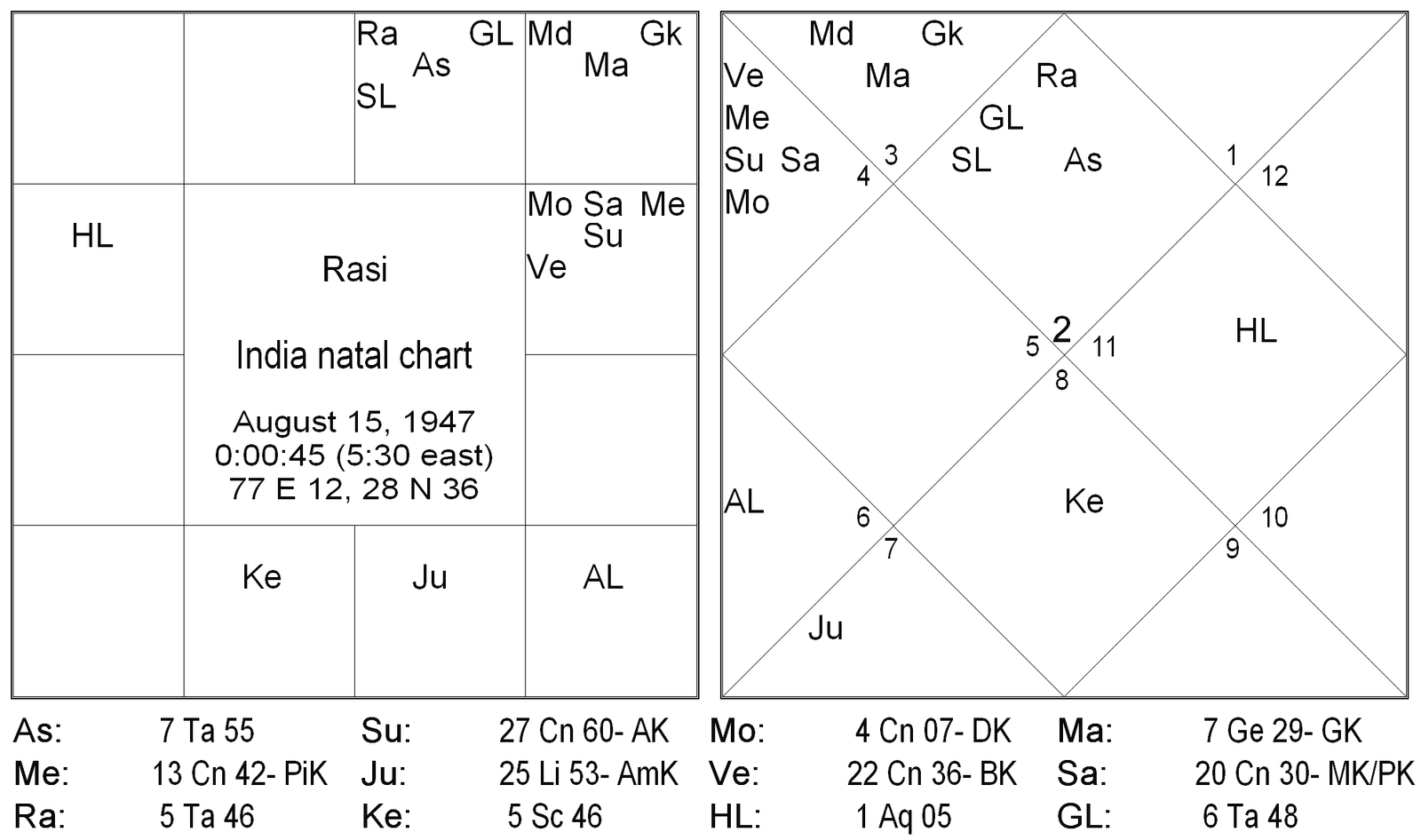
A great Raja-yoga occurs in this chart involving the lords of three out of four Kendras, as well as trinal lords Mercury and yogakaraka Saturn as well. Given that these form in the 3rd house, the chart shows great potential of India in connection to foreign commerce as well as the country’s potential to emerge as a recognized world power. The 3rd house may relate to the fulfillment of mundane and political aspirations on the one hand, as well as a vehicle through which the ancient teachings of the Vedas spring forth to a world audience. Up to the point of India’s independence from British rule, such possibilities never existed as the latter sought to keep India in poverty and political division as means of control and domination.
Pluto’s exact conjunction with the lord of the 9th and 10th houses [Saturn] is an ominous indication, however, of deeply divisive and covert politics going on within the country, and also a power struggle ensuing with its neighbor, most notably Pakistan. Pluto indicates nuclear power and that the country develops its nuclear capability and technology and uses it as leverage over neighboring countries. Note here also that Saturn is the Badhakesh in this chart (9th lord for fixed lagna charts), as well as Mahesvar, and thus can show that the government itself turns in on itself, or in many ways becomes its own worst enemy.
Following this point of view, note that Saturn and Pluto are in the first Kauluka of the Drekkana they are in, and this indicates powerful subversive forces from within the government of India itself. Thus it is quite possible that the election of its leaders, and the leading political party, are fraught with corruption, such as taking bribes from organized crime, ransom, and even kidnapping or assassination of Prime Ministers will take place.
The presence of Rahu in exaltation on the lagna of the chart, and then also Ketu in the 7th house aspecting the Paka lagna (sign of the lagna lord), indicates that secret plots and conspiracies are lodged against the country, and most notably covert actions such as terrorist attacks will become the rule rather than the exception as time goes on.
Jupiter plays a dual role, in that the Raja-yoga forms in the 10th from it which means that as soon as any dasha brings Jupiter into the picture, India will burgeon in terms of its prosperity and economic development, and will gain greatly from investments through foreign markets as well (note Jupiter’s aspect to the 12th house, as well as to the 12th lord Mars).
Jupiter, however, is Rudra in this chart, and thus those who would benefit from India’s prosperity, will also become India’s enemy. It is also indicated here that even if attacks occur (Ketu) suggesting vested interests by isolated groups of terrorist or radicals, big government as well as large corporate interests lie in the backdrop of such plots. Mark Jupiter in the chart of India whenever dasha periods during terrorist attacks occur, and see how organized corporate and government forces are responsible in the final analysis. Note the following final points with respect to Jupiter as well: It is Kharesh (lord of the 22nd Drekkana), as well as placed in an Ayudha (weapons and violence) Drekkana.
November 26, 2008: Terrorist Attacks on Mumbai
Dasa periods: Vimsottari dasa from Mandi Sphuta:
Taking Mandi’s naksatra degree for the calculation of Vimsottari dasa, it was Ketu’s major period when the Nov. 27, 2008 terrorist attacks on Mumbai occurred. Venus was the sub-period (Antaradasha); while Mercury was the Pratyantaradasha from Nov. 19th 2008 to Jan. 15, 2009. On the Suksma dasa level (4th level) it was Ketu again.
Mandi Vimsottari Dasa:
Ket MD: 2007-07-16 – 2014-07-15
Ven AD: 2007-12-12 – 2009-02-08
Merc PD: 2008-11-18 – 2009-01-15
Sookshma-antaradasas in this PD:
Merc: 2008-11-18 – 2008-11-26
Ket: 2008-11-26 – 2008-11-30 ***
Ketu and the “CSP” Principle
Ketu in the 7th house in strength in this chart, as mentioned above, makes India very vulnerable to terrorist attacks from foreign nationals in general, but especially during the dasha period of Ketu. This occurred when the transit of Ketu moved over the sign of Cancer where the greater emphasis of the chart lies, including lagna lord Venus is found. In the C.S. Patel Memorial Issue of this magazine, an excellent article on the “CSP” principle was given by Mr. R.G. Krishnan. The principle is that prosperity or general well-being of the country (or individual in natal charts) results from Rahu’s transit over or aspecting the Sun-Venus-Mercury arc. When Ketu transits over this arc, very dangerous events and misfortunes are likely to occur. This arc extends from the longitude of either of these three, whichever one is lower, to the higher one. In the case of India’s chart, all three of Sun-Venus-Mercury are in the sign of Cancer and thus this sign is very vulnerable to the effects of the nodes in transit. Note that on the date of the attacks, not only was Ketu’s dasha in operation, but Ketu itself was moving over this arc thus indicating that attacks are not only eminent, but very dangerous as well.
Pluto indicates nuclear power and that the country develops its nuclear capability and technology and uses it as leverage over neighboring countries.
Venus is the lagna lord and lord of the AD, and thus the physical well-being of the country is at stake, especially in places where entertainment occurs and in luxuriant places like hotels, restaurants, etc. These latter locations are exactly where the terrorists struck, in the heart of the entertainment and financial capitol of the country. Mercury as a maraka and the PD lord suggests that these attacks were performed by young persons, and also in a very congested or well-populated business district. Note here that both Venus and Mercury are both in Sarpa Drekkanas in the chart, and thus their dasha periods are prone to be dangerous. The trigger of the event came with the Suksma dasha of Ketu itself.
Narayana (Padakrama) dasa
The Narayana dasa operating at the time of the attacks was Libra/Scorpio/Pisces/Taurus:
Narayana Dasa (D-1 chart)
Li MD: 2002-08-15 – 2011-08-15
Sc AD: 2008-08-14 – 2009-05-12
Pi PD: 2008-11-14 – 2008-12-06
Sookshma-antaradasas in this PD:
Ta: 2008-11-27 – 2008-11-29 ***
It is significant here that Jupiter occupies the dasha rasi, and thus his dual role as described above comes into play. The period from 2002 to 2011 is thus a burgeoning period for India’s international commerce through connection to US corporations in particular, and it is also an expansive period so far as the teachings of the Vedas in all its forms are concerned. The Internet, being associated with the 3rd and 9th house axes, comes into play strongly during this time as the dasa rasi lord is Venus, and is also the lord of the lagna of the chart. The Jiva rasi (count as many signs from the dasa rasi, as it is removed from the lagna to get the Jiva rasi), or the sign indicating the life or Prana of the dasa, is Pisces/11th house, and thus this period shows considerable financial gain for the country, as well as prosperity of its citizens.
On the other hand, Jupiter is Rudra in the chart, and its role as the lord of the 8th house as well as his being Kharesh, are ominous so far as how this planet can function as a malefic as well. Due to its occupation of an Ayudha Drekkana, India will need to be very careful about all varieties of terrorist attacks during the Narayana dasa of Libra, especially those which originate through corporate interests and carried about by large, foreign governments.
Jupiter is also in the third Dwadasamsa of the Drekkana where it is placed, which is designated as Yama, and thus is prone to inflict death during its dashas, and this to carry out financial and foreign government interests. It is in a Manusya Navamsa, which means of human beings, and also is in the 2nd Kauluka of its Drekkana, which indicates open enemies, or attacks originating outside the country, and not within it. Finally, Jupiter occupies a Trimsamsa of Varuna (Jala, or watery), and thus the attackers came by way of boat and proceeded from the beach into the city.
Scorpio is the AD, which again is the 7th house (open enemies), and in which the terrorist influence of Ketu is placed. Pisces PD brings Jupiter back into the picture in the 6th house, while the Suksma dasa is finally Taurus, the lagna, which has Rahu very closely positioned in it. Transiting and natal Rahu/Ketu, as well as of Saturn, thus have sway over the lagna of the chart at the time of the attack. Kharesh and 8th lord Jupiter in transit joined lagna lord Venus in the natal 8th house (Sagittarius) at the time of the attacks, and thus the event was very dangerous to the well-being and longevity of the citizens.
Lunar New Year Chart: New Delhi, 2008
April 6, 2008
09:26 IST
New Delhi, India
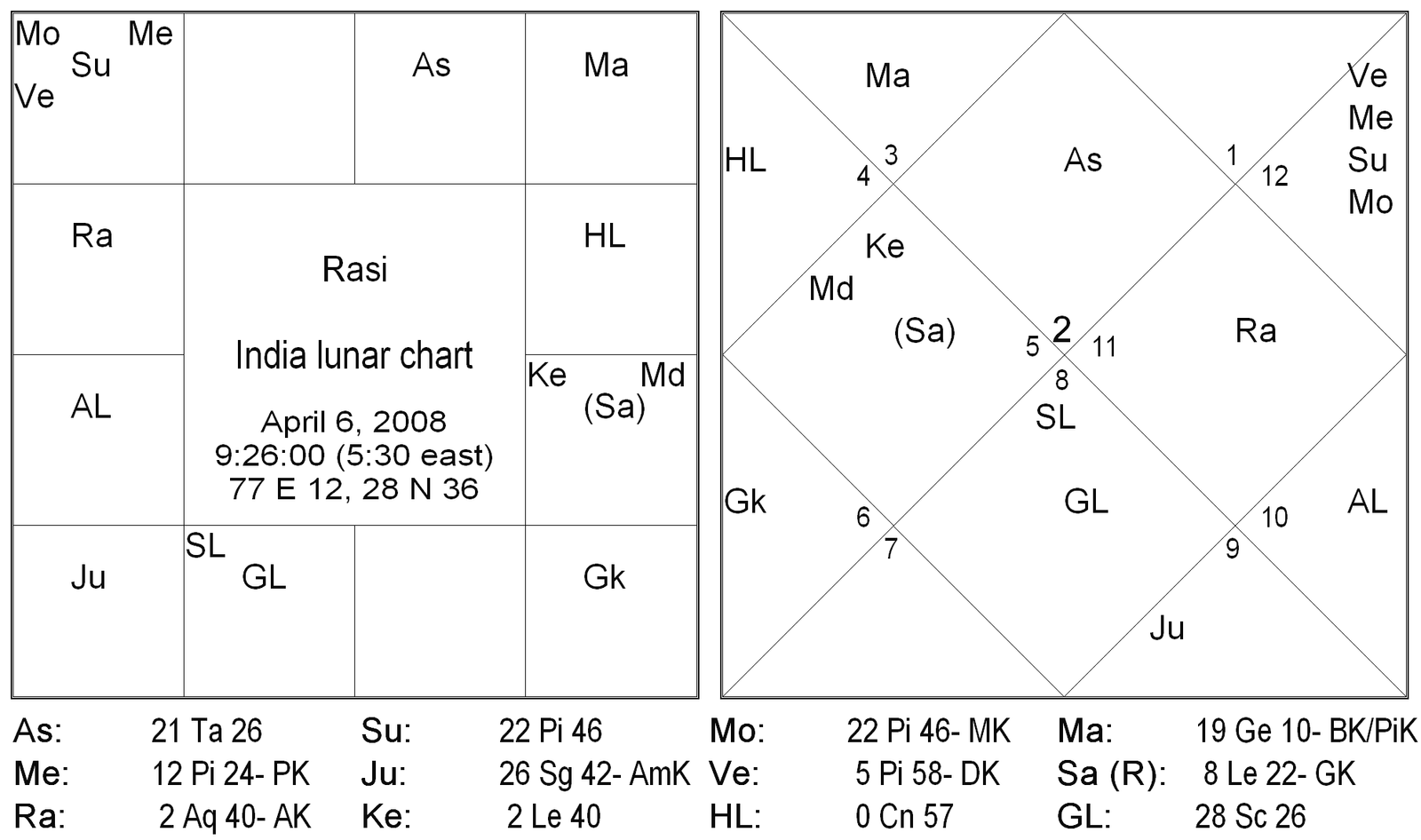
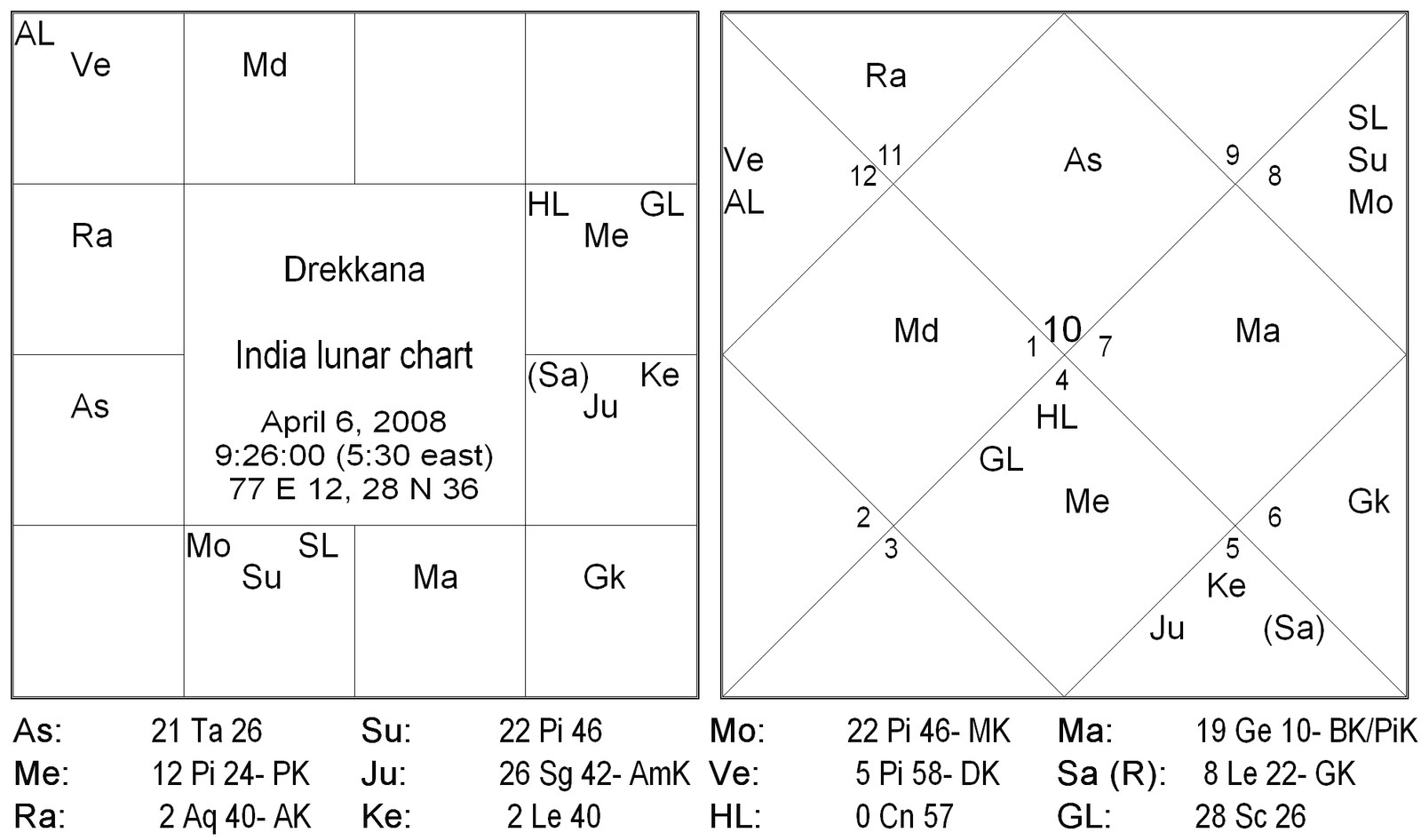
The mundane chart cast for the time of the New Moon in Pisces, or the Lunar New Year chart, is powerful in seeing and timing the influences upon a given country during a specific year. With respect to the terrorist attacks on Mumbai, we can see many important correspondences to this chart making use of New Delhi (India’s capitol) as the place of its calculation. Some of the most compelling points are as follows:
Retrograde Saturn and Ketu’s placement in the 4th house, aspected by a very powerful 8th lord and Rudra Jupiter from the 8th house, are ominous indicators of terrorism reaching the shores of India in the 2008-2009 year. Jupiter is also the Kharesh in this chart, in the same way that he is in the India natal chart.
Jupiter’s role in the execution of these attacks obvious, as (a) he is in an Ayudha (weapons) Drekkana just like he is in the natal chart of India; (b) he is in a Yama Dwadasamsa, as in the natal chart; and (c) he is in the 2nd Kauluka of the Drekkana occupied, which indicates that he is a outward enemy. Jupiter as a planet represents an organized effort by persons with money and, because Jupiter disposits the Sun, by a foreign government entity as well. Note in this connection that the Sun in the lunar New Year chart is also in Mrtyu-bhaga, with the clear interpretation being that a government seeks to inflict harm or death on India during the year in question.
Saturn and Ketu show the impact of covert attacks in the dead of night, and which perpetrate cruel and merciless punishments on innocent people. Jupiter’s occupation of the 8th house indicates that the government or financial interests that are behind the attack were of foreign countries, and were carried out in such a way so as to conceal their real identities.
Another important observation is that Jupiter is not only the Kharesh, but he also occupies the 22nd Drekkana (8th house of Drekkana chart) with both Saturn and Ketu as well. Thus, when the dasha periods of either Khara or Mrtyu Drekkana signs occur, or when Saturn/Ketu/Jupiter’s naksatra dashas operate, a terrible attack on India is sure to happen threatening the homeland and its population (4th house).
Mandi Vimsottari dasa
Sat MD: 2008-10-11 – 2008-12-06
Rah AD: 2008-11-19 – 2008-11-28
Pratyantardasas in this AD:
Moon: 2008-11-27 – 2008-11-28 ***
Mars: 2008-11-28 – 2008-11-28 ***
Calculating Vimsottari dasa from Mandi Sphuta, the dasa period operating on Nov. 27, 2008 was Saturn/Rahu/Moon, while the PD of Mars started early in the morning IST on Nov. 28, 2008. The Moon, as karaka of the 4th house, especially becomes vulnerable as in the lunar new chart, the Moon is completely without light at the Amavasya Tithi. The AD lord is Rahu, who rules the Amavasya and who perpetually seeks to eclipse the Moon two to four times per year.
Rudra Yoga: Rudra yoga is a terrible combination which brings about death when activated by the Shoola dasa in a natal chart, and will certainly bring forth the death-knell of Rudra in the mundane charts in which it forms as well. It applies when there are mutual aspects (rasi aspects) between the Moon, Mars, and Venus. Herein the activation of the PD of the Moon is highly significant in the Mandi Vimsottari dasa, as then the full effects of Rudra yoga manifested in the form of the violent attacks.
Once the attacks had been initiated, Mars’ effect came into operation in the very early hours of the morning of Nov. 28. This is when fires were set in historic hotels and restaurants in Mumbai. Mars is in the last of 4 Dwadasamsas in the Drekkana of its placement, and this is an Ahi (Sarpa) division which indicates very violent, angry, and ruthless warfare without any consideration of innocent citizens who may get caught in the crossfire. As a maraka lord for the chart and being placed in a maraka house, in addition to occupying the 64th Navamsa from the Moon, Mars is very destructive in this chart and his effects were thus obvious at the time of the attacks.
Trisphuta Vimsottari Dasa
Jup MD: 2008-10-16 – 2008-12-03
Rah AD: 2008-11-25 – 2008-12-03
Pratyantardasas in this AD:
Sat: 2008-11-27 – 2008-11-28 ***
With Trisphuta naksatra as the starting point for Vimsottari dasa, note that the period of Jupiter/Rahu/Saturn was in place on the date of the attacks in Mumbai. Here all of the most malefic and dangerous factors concerning (a) breach of the country’s security structure [Saturn/Ketu in the 4th house]; (b) attacks directly perpetrated on the government of India itself [10th house by Rahu]; and all of this having a systematic organization and funded by a foreign government [most likely Pakistan, with the aspect of Jupiter] all come into question. Note in this connection that Jupiter not only is Rudra in this chart, but he also activates the Rudra yoga during his dasa, due to his rasi aspect onto all three planets forming the yoga: Moon, Mars, and Venus.
Further research is needed of mundane charts in order to ferret out the details of how all the above principles may play out in the actual experience of country’s or regions during specific years. While this article focused mainly on the issue of terrorist attacks, there is much work needed in researching how natural disasters, epidemics, economic collapse, or other such anomalies to countries may be seen in mundane charts. It is expected that the above will invest some energy in the minds of astrologers for researching this important branch of the art of Jyotish.
About Author: Robert A. Koch is a professional Vedic astrologer with over 20 years’ experience in the field. His articles have appeared in numerous Vedic astrology journals, and he is a popular speaker at Vedic astrology conferences and seminars. He has an international clientele and student base from all walks of life. Robert released his first book in 2005 entitled, The Spiritual Dimensions of Vedic Astrology, which has earned world-wide acclaim among scholars and astrologers alike. (See https://robertkoch.com/book.html.)


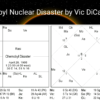

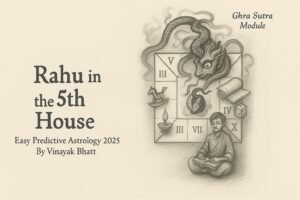

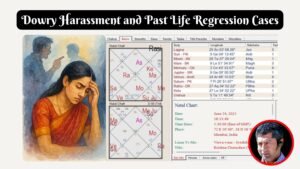






Leave a reply
You must be logged in to post a comment.